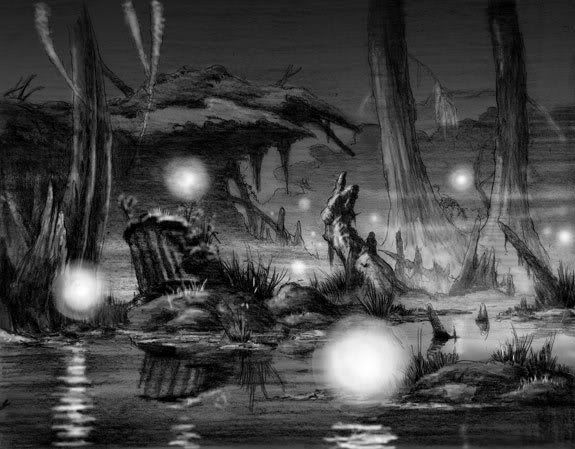By Joan Seth
Will-o'-the-wisps are traditional depictions of ghostly lights often seen at night or twilight over swamps or marshes. They resemble flickering lights and are said to disappear suddenly when approached. Here, we take a look at various types of Will-o'-the-wisps in various Asian folklore.

Chir Batti (Ghost light) of Banni grasslands and the adjoining marshy salt flats of the Rann of Kutch in Gujarat State, India. It is described as a strange light as bright as a mercury lamp that changes its color to blue, red and yellow and resembles a moving ball (reported also pear shaped form) of fire, which may moves as fast as an arrow but may also stop. It is not just one light, but could appear at several places. The light has also been observed to becomes two from one.
Doggaebi bul (도깨비불) in Korea, "Doggaebi" being a traditional friendly monster with one or two horns on the head, and "bul" meaning fire.
Gandaspati in Indonesia, especially Central Java, a wicked spirit in flame that can take the form a dragon, and causes the death of whoever touches it.

Guǐ huǒ (鬼火) in Chinese, literally ghost fire. Often seen in graveyards or other places where dead bodies gather. As the dead bodies rot and decay phosphine is produced which spontaneously ignites in air in hot weather, the flames producing the sporadic lights seen in hot summer nights. Sometimes also referring to the completely different phenomena of phosphorescence or more rarely, ball lightning.

Kolli vai pisaasu, a Tamil term used to describe a ghost (pisaasu) with burning embers (kolli) in its mouth (vai). There is a contention whether will-o'-the-wisp and kolli vai pisaasu are the same.

Kra Sue (ไฟกระสือ) Thai. Appears in the shape of fire ball flying over the dumping areas where, in the old times, Siamese people buried their excrement and the midwives dumped the placenta after giving birth. Hence it is believed that this "ghost" lived on the consumption of this waste. It is claimed that the fireball flickers on the heartbeat rhythm so that it is assumed to be the soul of a woman. Some reported that the true form of Kra Sue is a head of woman together with her entire digestion organs from esophagus to entrails, a heart, and lungs, flying in the night time preying on small lives. The flickering light observed is emitted from her heart.

Mekong lights or Nekha lights in Thailand and Laos are one of those fantastic manifestations of nature that science has yet to adequately explained. Apparently, in the Mekong River, near Nong Khai, Thailand, lights will appear under the river within a length of a few hundred meters. These lights slowly float to the surface and then shoot out like missles into the sky and out of sight. They are the size of beach balls. The local name for them is the Nekha lights. The Nekha is a large fish which lives in the river. Locals also claim the lights are actually the eggs layed by a giant serpent.

Onibi (鬼火) Japanese meaning ghost/demon fire. It's sometimes associated with or mistaken for the trickster 人魂 (hitodama or "human soul"), blue or green floating balls of fire assumed to be souls of people with unfinished business. Other Japanese myths consider the phenomenon a trick of the kitsune, employing their "fox-fire" (kitsune-bi) to lead travelers astray.











0 comments:
Post a Comment